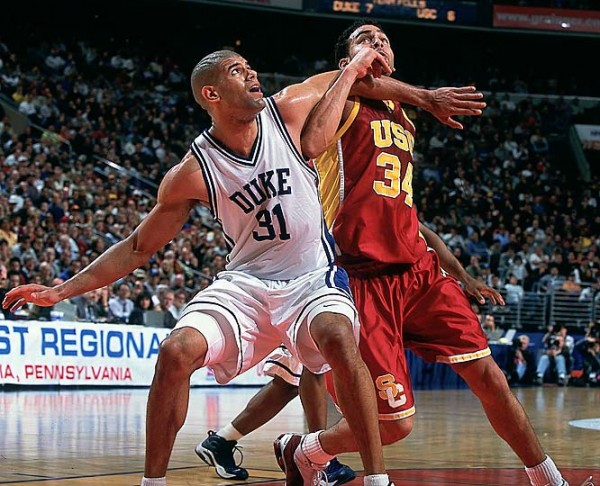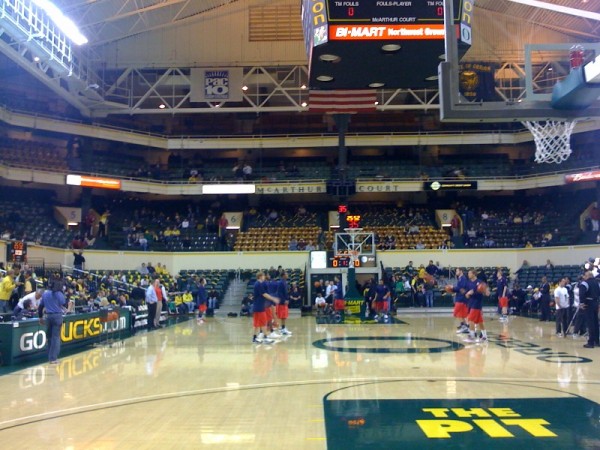Evaluating the NCAA Rule Change Proposals
Posted by rtmsf on May 10th, 2010Usually the discussion of rule changes is about as sexy as Heidi Montag’s visible scarring around her bosom, but hey, it’s the offseason and we’ve never been ones to turn away from a perfectly good plastic appendage just because of a few imperfections. The NCAA Rules Committee came back with its annual recommendations last week, and there are three primary ones to take note of this year. Although the media has been rightfully focused on the immediate recommendation regarding the wanton throwing of elbows (more on this below), it was two of the other experimental recs (one men’s and one women’s) that caught our eye. Both involve line-drawing (or more accurately, curve-drawing). Maybe we’re just anal when it comes to court geometrics, but we prefer clearly defined rules and a clean-looking playing surface. Both of these proposed experimental rules will help with those objectives.
First, we’ve griped for what seems like an eternity about the “Shane Battier” rule — the notion that players in the college game could set up to take a charge directly underneath the basket even when the offensive player had already left his feet prior to the secondary defender/charge-taker getting into position. The NBA never had this problem in large part because referees were hesitant to call it (and players wanted to avoid certain posterization), but for the last fifteen years or so it was one of the most despised calls in college basketball. Nothing infuriated us more than watching a spectacular offensive move into the lane get erased as a slow helpside defender rushed to set up under the rim, received contact, flopped onto his rear along the baseline and looked for the call. More often than we’d care to remember, the johnny-come-lately defender would be rewarded with the offensive foul, the basket would be erased, and steam would gently rise from our ears.
Last year the NCAA finally began to address this problem by enabling an imaginary restricted zone underneath the basket where charges would not be called, a clear response to the NBA’s recent success in adding a restricted area underneath its hoops. This worked well enough to eliminate the most infuriating transgressors — those who would camp out directly underneath the rim — but the imaginary aspect of the collegiate “line” still left way too much discretion in the hands of the officials. Depending on the officiating crew working that night, the imaginary arc might extend out only a couple of feet from the front of the basket; whereas in others, it may extend out three, four or even five feet. The existing rule using the invisible line was a good faith effort by the NCAA to clean up play under the rim, but it is just too difficult and ambiguous for referees to consistently apply from game to game. In response, the NCAA has moved closer to providing greater clarity with an experimental rule effective next season that will allow a restricted area arc in the paint for the preseason tournaments and exhibition games. Once everyone sees how well it works in those contests, our hope is that it will become a standard part of the floor in coming years.
The second rule change is only cosmetic when it comes to the men’s game, but for some reason it really bothers us to see courts that have multiple three-point lines on it. A new experimental rule for next year’s women’s game involves moving their three-point line back to the 20’9 distance that the men currently use. An analysis performed by the NCAA found that nearly two-thirds of attempts in the women’s game were already coming from behind the longer line and the corresponding make percentages were similar. Hopefully this is the first step to unifying the three-point line distance between sports and getting rid of the unsightly redundancy on courts that host both men’s and women’s games (i.e., most of college basketball).
The last rule change is the only one that will actually take hold throughout the entirety of Division I basketball next season. The NCAA is toughening its stance on offensive players throwing elbows with the ball to clear space. If a player makes contact with a defender above the shoulders using an elbow, the official now has no choice but to call at minimum an intentional foul (two shots + the ball for the opponent) and quite possibly a flagrant foul (automatic ejection for the perpetrator). The intent of the rule is to legislate a dangerous play out of the game altogether in much the same way that you hardly ever see punches thrown on the court anymore (the penalties are very strict).
In theory, this sounds wonderful. After all, swinging ‘bows at head level are assuredly one of the most dangerous plays in the sport. Our concern, however, is what happens in situations like the below two? Not all games in D1 are televised so that the officials can go to the replay monitors to make sure exactly what happened; how do the refs handle an inadvertant elbow that results in a bloody mess if they never saw it happen, as in the Duncan/Nash example from the NBA Playoffs below?
Correspondingly, how will the refs handle those who choose to feign the result of a thrown elbow, as Tyler Hansbrough does below? Again, it’s easy to later determine what happened when there are monitors with multiple television angles available, but that won’t always be the case in many of the non-power conference games.
Then there’s the issue of defining “above the shoulders.” Any space-clearing that a player like JaJuan Johnson does (at 6’10) will by definition be above most other players’ shoulders — should he be penalized differently simply because he’s taller than the average guard? Our hope is that college basketball officials next season will be circumspect when utilizing these two foul calls, saving the trump card for the most obvious transgressions. Most players have been taught legal space-clearing techniques for the better part of their lives, so we’re a little concerned that the NCAA’s square peg here isn’t going to fit into all possible round holes. We shall see.












































